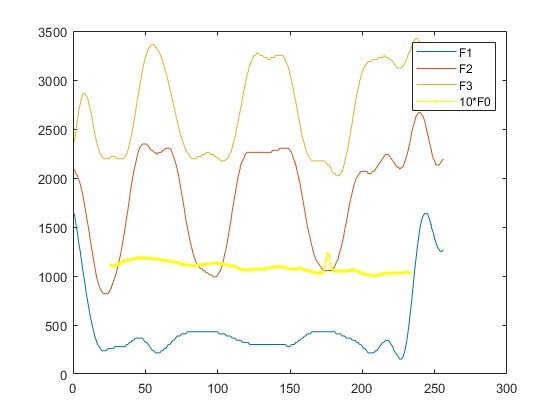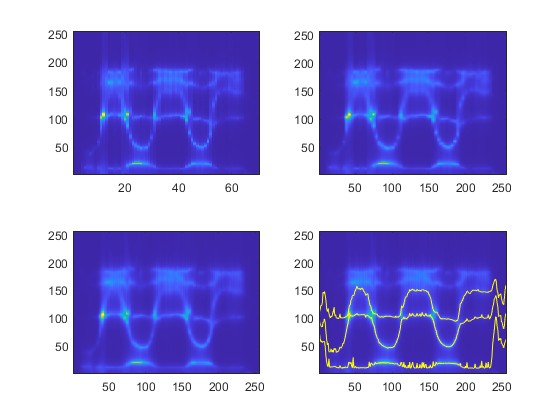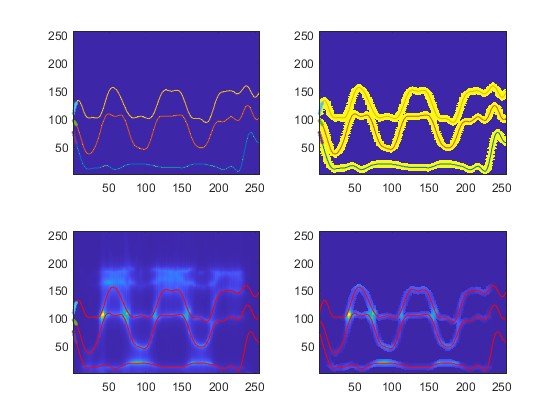1.完整项目描述和程序获取
>面包多安全交易平台:https://mbd.pub/o/bread/Y5mamp9u
>如果链接失效,可以直接打开本站店铺搜索相关店铺:
>如果链接失效,程序调试报错或者项目合作也可以加微信或者QQ联系。
2.部分仿真图预览



3.算法概述
共振峰轨迹的自动跟踪算法,其特点是不借助于其它的信息来源,仅仅是基于语谱图信息,来确定语谱图上前四个共振峰频率的位置和它们关于时间轴的轨迹.算法由三个层面构成;第一层面是进行频率分布的分析,以决定一个最佳的共振峰搜索起始位置;第二层面是采用双搜索算法,来跟踪随时间变化的共振峰轨迹;第三层面是解决某些冲突现象.
4.部分源码
function [fmap,pt2] = ftrack(y,fs)
bDisplay = 1;
Fsamps = 256; % sampling resolution in frequency dimension
Tsamps = round(length(y)/18000*256); % sampling resolution in time dimension
tmp_img1 = zeros(Fsamps,Tsamps);
ct = 0;
numiter = 8; % number of iterations to run. seemed like a good number
for i=2.^(8-8*exp(-linspace(1.5,10,numiter)/1.4)),
% Determine the time-frequency distribution at the current
fix(length(y)/round(i))
round(i)
[tmp_img1,ft1,pt1] = lpcsgram(y,fix(length(y)/round(i)),round(i),fs);
% Get the dimensions of the output time-frequency image
[M,N] = size(tmp_img1);
% Create a grid of the final resolution
[xi,yi] = meshgrid(linspace(1,N,Tsamps),linspace(1,M,Fsamps));
% Interpolate returned TF image to final resolution
tmp_img2 = interp2(tmp_img1,xi,yi);
ct = ct+1;
% Interpolate formant tracks and pitch tracks
pt2(:,ct) = interp1([1:length(pt1)]',pt1(:),linspace(1,length(pt1),Tsamps)');
ft2(:,:,ct) = interp1(linspace(1,length(y),fix(length(y)/round(i)))',Fsamps*ft1',linspace(1,length(y),Tsamps)')';
% Normalize
tmp_img3(:,:,ct) = tmp_img2/max(tmp_img2(:));
if bDisplay,
subplot(221);imagesc(tmp_img1);axis xy;
subplot(222);imagesc(tmp_img2);axis xy;
subplot(223);imagesc(squeeze(mean(tmp_img3,3)));axis xy;
drawnow;
end;
end
% Determine mean tfr image and formant track
tmp_img4 = squeeze(mean(tmp_img3,3)); % tfr
ft3 = squeeze(nanmean(permute(ft2,[3 2 1]))); %
if bDisplay,
subplot(224);imagesc(tmp_img4);axis xy;
hold on;
plot(ft3,'y');
end;
% convert fmnts to image
tmap = repmat([1:Tsamps]',1,3);
idx = find(~isnan(sum(ft3,2)));
fmap = ft3(idx,:);
tmap = tmap(idx,:);
% filter formant tracks to remove noise
[b,a] = butter(9,0.1);
fmap = round(filtfilt(b,a,fmap));
pt3 = nanmean(pt2');
pt3 = (pt3-nanmin(pt3))/(nanmax(pt3)-nanmin(pt3));
% Rescaling is done after display code
if bDisplay,
imap = zeros(Fsamps,Tsamps);
ind = sub2ind(size(imap),fmap(:),tmap(:));
imap(ind) = 1;
tpts = tmap(:,1);
figure;
subplot(221);
imagesc(imap);axis xy;hold on;
plot(tpts,fmap(:,1),tpts,fmap(:,2),tpts,fmap(:,3));
idx = [1:5]';
plot(tpts(idx),fmap(idx,1),'.-',tpts(idx),fmap(idx,2),'.-',tpts(idx),fmap(idx,3),'.-');
subplot(222);
% Create a wider formant track
anisomask = anisodiff(imap,6,50,0.01,1);
imagesc(anisomask>0);axis xy;hold on;
plot(tpts,fmap(:,1),tpts,fmap(:,2),tpts,fmap(:,3));
idx = [1:5]';
plot(tpts(idx),fmap(idx,1),'.-',tpts(idx),fmap(idx,2),'.-',tpts(idx),fmap(idx,3),'.-');
subplot(223);
imagesc(tmp_img4);axis xy;hold on;
plot(tpts,fmap(:,1),'r',tpts,fmap(:,2),'r',tpts,fmap(:,3),'r');
idx = [1:5]';
plot(tpts(idx),fmap(idx,1),'.-',tpts(idx),fmap(idx,2),'.-',tpts(idx),fmap(idx,3),'.-');
subplot(224);
imagesc(tmp_img4.*(anisomask>0));axis xy;hold on;
plot(tpts,fmap(:,1),'r-',tpts,fmap(:,2),'r-',tpts,fmap(:,3),'r-');
% idx = [1:5]';
% plot(tpts(idx),fmap(idx,1),'.-',tpts(idx),fmap(idx,2),'.-',tpts(idx),fmap(idx,3),'.-');
plot(256*pt3,'y.-');
end;
% Rescale to Actual Formants and take the mean of pitch tracks
fmap = (fs/2)*(fmap/256);
pt2 = nanmean(pt2');
A112





































